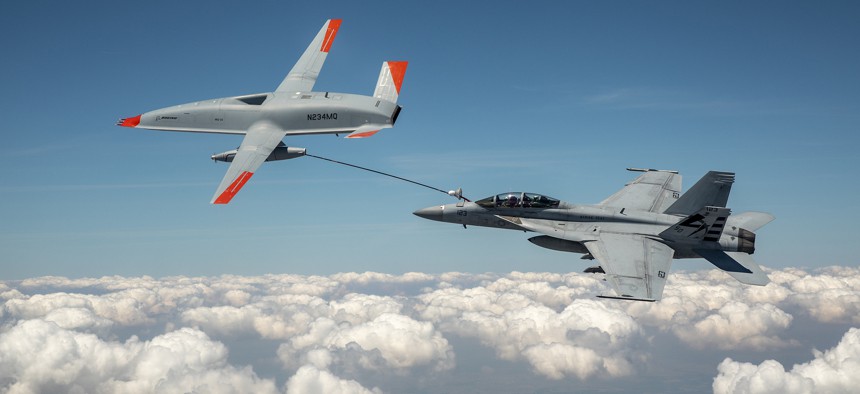
The Boeing MQ-25 T1 sends fuel to a U.S. Navy F/A-18 Super Hornet during a June 4 test flight, the first time an unmanned aircraft has refueled another aircraft. Boeing
Navy Drone Refuels Fighter Jet, a Key Step Toward Adding UAVs to Carrier Wings
The MQ-25 T1 Stingray is slated for tests on an aircraft carrier later this year ahead of a planned 2025 deployment.
A Navy test drone refueled a crewed fighter jet over Illinois on Friday, a key step in the service’s plans to incorporate unmanned aircraft into carrier air wings.
Two test pilots flying an F/A-18 Super Hornet took on some 325 pounds of fuel from an MQ-25 T1 Stingray unmanned aircraft while evaluating various aspects of flying near the drone.
“Friday’s historic test gets us one step closer to providing MQ-25’s critical capabilities to the fleet. To build that foundation for integrating manned and unmanned platforms to give our forces the competitive advantage to keep ahead of the evolving threats in the 21st century,” Capt. Chad Reed, the program manager for the Navy’s Unmanned Carrier Aviation program office, told reporters Monday.
The Boeing-built MQ-25 is to become the first unmanned aircraft added to carrier air wings, for which it will handle some intelligence, surveillance, and reconnaissance tasks along with its refueling duties.
The refueling test flight took place from MidAmerica Airport in Mascoutah, Ill., according to the Navy. The Super Hornet, carrying two test pilots, approached the drone and evaluated several aspects, including its stability in close proximity to the aircraft, the drone’s wake on the fighter, and the deployment of the fuel hose and refueling basket, Dave Bujold, Boeing’s MQ-25 program director, said on Monday. During the test flight, the drone transferred 300 pounds of fuel at 10,000 feet from its fuel pod, and later transferred 25 pounds at 15,000 feet.
Boeing video
“The importance to the program is early confidence in the design and the aerodynamics of this transfer,” Bujold said about the test flight.
The Navy currently refuels F/A-18s with other F/A-18s, taking away aircraft from operational use. The MQ-25 is meant to take on the refueling mission so more Super Hornets can be freed up.
Bujold said the refueling was so quiet the pilots were able to have a conversation in the cockpit, which can be difficult when flying behind another F/A-18’s engines. The wake behind the drone was also “smooth,” he added. The test flight lasted about four and a half hours.
In March, Vice Adm. James Kilby, the deputy chief of naval operations, said that one day drones could make up about 40% of a carrier air wing. The T1 is Boeing’s only flyingMQ-25, but they plan to build nine more for testing. The Navy plans to spend $47 million on the program in its 2022 budget request.
Tests of the drone will continue over the next several months, to include deck handling demonstrations aboard an aircraft carrier later this year. Reed said the Navy is also planning to fly an E-2 Hawkeye aircraft behind a MQ-25 to demonstrate other refueling possibilities. The drone will reach initial operational capability by early 2025, according to the Navy.




